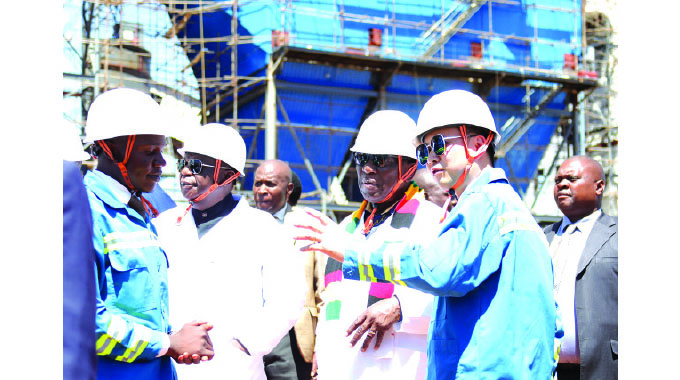Beyond the 100-day initiative
Rudo Grace Gwata-Charamba Correspondent
THE first wave of the 100-day initiative in Zimbabwe, crafted following the appointment of the new Cabinet in December 2017, is expected to end within a few weeks. Against this background, questions such as, “So what?” and/or “What next?” are, and rightly so, likely to arise among many stakeholders.
Answers to these questions lie within the basic principles of the related approach that uses a series of short-term projects to achieve long-term goals. Each project follows a life-cycle that includes the shape, launch, implement and scale-up phases.
During the shaping phase, key stakeholders jointly define areas of focus in line with the overall strategy of the organisation. This is followed by a launch occasion, which usually lasts one day, where the team sets its own ambitious goals that stimulate innovation and experimentation.
The teams then drive the implementation phase, typically for periods between 30 and 100 days. Halfway through implementation of the project, teams review the project processes to track and report on progress and results as well as to generate lessons.
At the completion stage, teams conduct a final review to report and to celebrate final results, to share the lessons learned and also to share plans relating to ways of sustaining results over time.
Soon after, preparations for the scale-up phase begin.
The programme in Zimbabwe is moving towards this scale-up phase, where the process is replicated across multiple organisational units or regions, while the related results achieved continue to advance the achievement of the overall organisational strategy. Such scale-up gets stimulated by the achievement of tangible, positive changes (results) combined with the enthusiasm and energy that derives from successes scored during this ending first wave.
Expected outcomes (results) from 100-day initiatives
100-day projects are expected to achieve results as well as generate lessons that are integrated into management decisions to improve performance.
In the context of Results-Based Management (RBM), results or outcomes refer to the actual or intended intermediate effects on the target population, which are represented by signs of change in capacity and quality of service delivery or actual change in development conditions that interventions are seeking to support.
That is, a causal/direct relationship between deliverables of the project and the identified change should be evident, otherwise the change would not qualify to be a result.
During the course of implementing the projects, teams look out for, and recommend any adjustments that would promote the sustainability of its result for the longer term, beyond the project-end.
Therefore, the information on project performance, against targets that are expressed as a set of result indicators, as well as information on adjustments for sustainability, is reported on.
Several factors that include the targeted ultimate result, nature of the project, its context and group of stakeholders, influence the levels and nature of results.
In the case of the 100-day initiatives, which are part of a larger project cycle, deliverables will have an effect on all stakeholders, albeit at different levels.
That is, significant levels of results or successes may be limited on certain groups of stakeholders. However, each project is expected to significantly contribute towards the achievement of a critical goal.
To put the discussion into context, it may be worthwhile to consider examples of expected results in some groups of stakeholders towards end of the 100-day cycle in Zimbabwe.
For the civil service in general, staff are expected to gain significant capacity due to the resourcefulness and persistence generated through efforts to achieve goals that are meaningful to them.
Also, implementing the initiative helps to overcome inertia, resistance to change and fear of added responsibility. These changes, together with the introduction of a culture of results, are expected to help in laying a foundation for stronger performance in the subsequent cycle. Such expectation is against a background where this group of stakeholders is often perceived to have a poor work culture while, at the same time, the individuals view themselves as victims of a dysfunctional system.
In addition, those individuals might have had a legacy of poorly executing development projects characterised by the abandoning of on-going programmes and starting new ones that do not have any linkages to the former.
Consequently, within this group, there is widespread scepticism and consistently declining self-confidence in relation to capacity, factors which stifle the capacity to embrace accountability and professionalism.
Change is, therefore, expected. Literature on similar initiatives most notably in Eritrea and in Madagascar, show that this approach overcame shortcomings to create and sustain real empowerment, motivation and innovation to work towards the achievement of results.
This is primarily because, all the way through the execution of the 100-day projects, teams are held accountable for achieving results through innovation, and also for extracting learning and insights which help to shape and reinforce a new identity among the project implementers, making them capable, resourceful, and innovative professionals. That is, results are achieved while at the same time confidence, discipline and stamina required for the achievement of long-term results, which are built gradually.
Within the agricultural sector, Command Agriculture programme is expected to realise the greater goal of food security. The 100-day cycle under the Command Agricultural programme could include results such as increased hectarage initially, and improved harvest later, changes which would only be significant and directly relevant to farmers rather than all stakeholders. However, there will still be changes for the rest of stakeholders, albeit smaller in size compared to the farmers. These smaller changes include hope for a brighter future without food shortages and reduced levels of anxiety to the extent that these changes are not concrete or tangible, they are thus qualitative.
Similarly, within the industry and commerce sector, increased confidence and positive change of mindsets as well as enhanced capacity are examples of results which may appear to be confined to only certain groups of stakeholders, when in fact these changes have impacted on all stakeholders. The same elements that enhance investor confidence are very likely to negate anxiety among all stakeholders. That way, the cycle of results and benefits widens until the ultimate goal is achieved.
Lessons are drawn from both meeting or exceeding targeted results (which is typically expected) and missing some, with the latter regarded as a rich source of learning and insight that helps future teams to focus on areas where success is more likely.
That way, both results and lessons learnt from the portfolio of 100-day projects are implanted into the organisation for future use in expanded application. As soon as 100-day cells created for experimentation and innovation have proven their worth, change can be scaled-up across the whole system on the basis of demonstrated value, rather than belief and guess-work where the related risk is inherently higher.
Also, interventions that show indications of limited sustained impact are avoided during the scale-up phase.
The confidence and conditioning among stakeholders required for higher achievement increases with the implementation of each wave and thus, in the process, builds the necessary capacity for each subsequent and more challenging wave of implementation.
Once the success of a project is clearly demonstrated and acknowledged, key stakeholders, including sponsors and change leaders jointly consider opportunities that are available for the scale-up in view of the particular team’s insights.
Information on results, together with emerging good practices, is continuously fed into the ensuing scale-up phases.
Opportunities for scale-up include turning fresh attention to new issues or related challenge identified during the just-ended wave. The other opportunity is extending experiments from the ending projects to other groups of stakeholders or extending insights from best practices to the same for adoption or further development and discovery.
It may be worthwhile to encourage adoption of the approach by all sectors of the economy, including the private sector. Cross-cutting or supporting activities across locations are often identified from 100-day projects and included in the overall portfolio adjustments and for scaling-up.
Strategies for sustaining the momentum gained from the preceding wave and to continue promoting the growth of a culture of results (characterised by the desire to focus on making a difference) are continuously developed to improve performance as well as to institutionalise the RBM approach.
Leveraging on effective presentation and sharing of results to clearly demonstrate the benefits derived from the implementation is one such strategy.
Similarly, continuous provision of information on success stories, including those from other nations, as well as enhanced interaction and feedback among both internal and external stakeholder (particularly the end-users or customers), often helps to promote demand for the initiative within as well as across sectors.
Also, implementers should be encouraged to concentrate on changing behaviour towards adopting a culture of results and developing themselves into results champions, rather than solely concentrating on getting results.
Transformational leadership that continuously influences stakeholders to challenge and change embedded norms, values and attitudes is essential throughout the implementation phases.
Also, whenever feasible, inexpensive incentives need to be introduced for purposes of motivating stakeholders so they commit themselves to higher performance levels. A typical example of such an incentive, which proved to be particularly effective in Madagascar, was affording successful implementers an audience with very high ranking officials.
Overall, it is essential that all stakeholders genuinely appreciate the value of 100-day initiatives at the heart of RBM for them to contribute to enhanced performance.
Dr Rudo Grace Gwata-Charamba is a project/ programme management consultant and researcher with a special interest in Results Based Management (RBM). She can be contacted via email: [email protected]





Comments